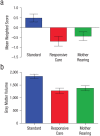Early Socioemotional Intervention Mediates Long-Term Effects of Atypical Rearing on Structural Covariation in Gray Matter in Adult Chimpanzees
- PMID: 29381427
- PMCID: PMC5902648
- DOI: 10.1177/0956797617740685
Early Socioemotional Intervention Mediates Long-Term Effects of Atypical Rearing on Structural Covariation in Gray Matter in Adult Chimpanzees
Abstract
Atypical rearing has deleterious effects on chimpanzee behavior during development, some of which can be ameliorated with a responsive care intervention (RCI). Here, we obtained in vivo magnetic resonance images of adult brains of 27 chimpanzees given institutional care, with and without RCI, and compared them with those of 16 chimpanzees mother-reared from birth. We found significant long-term rearing effects on structural covariation and gray matter volume, specifically in the basal forebrain (i.e., caudate, putamen, nucleus accumbens, rectus gyrus, and orbital prefrontal cortex), indicating that RCI prevented brain changes due to atypical rearing. A significant correlation between covariation in these brain areas and caregiver nurturing, experienced in the first month of life, suggests a possible developmental mechanism for the effect of early experience on brain networks. We identified an early intervention that prevents changes in the basal forebrain that otherwise emerge as a consequence of institutionalized rearing without species-typical socioemotional experiences.
Keywords: brain; great apes; institutionalization; nurturing experiences; source-based morphometry.
Conflict of interest statement
Figures


References
-
- Bakeman R., Quera V. (2011). Sequential analysis and observational methods for the behavioral sciences. New York, NY: Cambridge University Press.
-
- Bard K. A. (1994). Evolutionary roots of intuitive parenting: Maternal competence in chimpanzees. Early Development and Parenting, 3, 19–28. doi:10.1002/edp.2430030104 - DOI
-
- Bard K. A. (1996). Responsive care: Behavioral intervention for nursery reared chimpanzees. Ridgefield, CT: Jane Goodall Institute.
Publication types
MeSH terms
Grants and funding
LinkOut - more resources
Full Text Sources
Other Literature Sources

